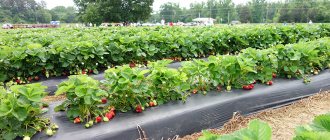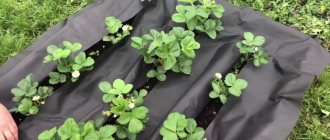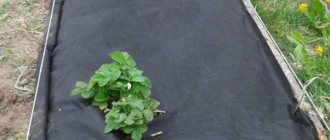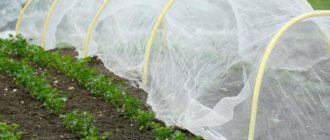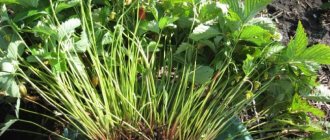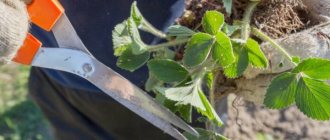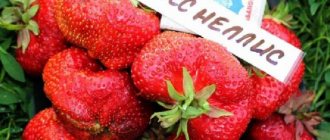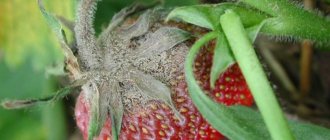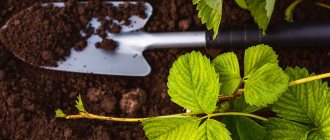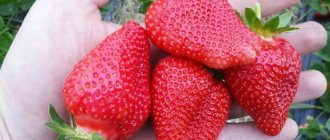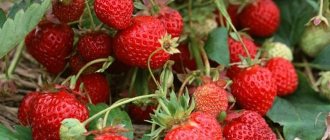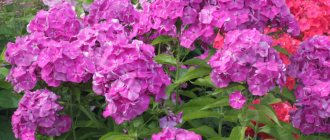Features of growing strawberries under film
The subtleties of growing strawberries under film:
- The place where the berry rows will be located is dug up to a depth of 15-20 cm.
- Manure and mineral fertilizers are added to the soil.
- The top of the soil is covered with straw, hay, aged compost and other mulching material.
- To protect against pests living in the ground (mice, moles, shrews and others), sheets of cardboard or a metal mesh with small cells are buried under the beds to a depth of 20-25 cm.
- The beds are covered with film.
- Strawberry bushes are planted in slots made at a distance of 20 cm in each row. Row spacing is 65-70 cm.
Choosing agrofibre
Today there are a large number of agrofibre manufacturers on the market. Agrofibre itself has many varieties in color, purpose and density. In order to start growing strawberries using mulching, it is better to take black agrofibre with a density of 60 g/m2. It lasts more than 3 seasons. If it is necessary to protect strawberries from bad weather conditions, you need to use white agrofibre, having a density of 17 g/m2 (it protects against sunburn, hail, heavy precipitation, birds, etc.) to 60 g/m2 (protects against frosts up to -9 degrees). The width of the agrofibre must be selected according to the width of the bed. The most common widths are 1.6 m and 3.2 m.
Return to contents
Advantages and disadvantages of the method
Growing strawberries under film has the following advantages:
- No weeds under the covering material. Grass can only grow in holes near strawberry plants and can be easily removed.
- Under the film the ground remains constantly moist. Requires much less water for irrigation compared to the traditional method of growing strawberries.
- The whiskers cannot take root in the shelter. If you want to obtain planting material, they can be cut off and germinate in another place.
- Bushes and berries are much less likely to become infected with pathogens that live in the soil.
- The berries do not come into contact with the soil and do not rot during heavy rainfall.
- On the surface of the covering material, the berries warm up better and ripen faster.
- Pest control is easier. The film becomes a barrier to their penetration into the fruits and leaves.
This method also has disadvantages:
- If the summer is rainy, mold and fungal colonies can develop under the film in the dampness.
- Weeds can grow through the roots and are difficult to remove in this case.
- Additional costs are required for plant protection products.
- Purchasing agrofibre requires large expenses. The more durable the fiber, the more expensive it is.
- To effectively irrigate crops, you will need to install drip irrigation systems.
Film or agrofibre?
Growing strawberries is always a rather labor-intensive process. Both film and agrofibre are pretty good means, but the opinions of gardeners are divided. Some people consider film to be the best product, while others consider agrofibre to be such.
If the film is purchased from a reliable manufacturer, there is no doubt about its quality. But if you accidentally purchased a low-quality film, then be prepared for the fact that the soil may overheat in the summer due to the fact that the film does not allow air to pass through. In addition, such a film may not last long - despite the stated service life, it may last for 1-2 seasons. It is also not recommended to use such a film for longer than 1-2 months due to the suppression of soil microflora and the strawberries not receiving the elements they need. Another drawback: even in mild frost, the film freezes due to the condensation that forms, and for this reason it requires additional heating.
Straw might seem like a good option, but it doesn't withstand strong winds and can attract rodents. If you take sawdust, they are effective when used with agrofibre because they are susceptible to weathering. When preparing for winter, their layer must be at least 8 cm, and without auxiliary material it will be difficult to maintain their even distribution throughout the bed. In addition, when using sawdust and straw, it is also necessary to add nitrogen-containing fertilizers to the soil, since both straw and sawdust take the nitrogen needed by plants from the soil. If you use decorative mulch (pine needles, gravel, wood chips), do not forget to take into account that during watering, some of the moisture may be retained in the layer of organic mulch, for this reason it is necessary to check the soil moisture underneath it. Remember that bark, sawdust or leaves tend to caking, and therefore the process of rotting may begin. To prevent this from happening, you need to loosen the mulch from time to time.
At the same time, agrofibre is capable of allowing moisture and air to pass through, which provides protection from low night temperatures and allows plants to “breathe”. The cost of this material is slightly higher than that of film, but its consumption is more economical due to its long service life. The structure of agrofiber is porous, so plants can be watered with liquid fertilizers or water without it. The soil has the ability to breathe, receive and retain moisture. Black agrofibre can be left untouched all year round. The main thing is to securely secure the material to the ground so that it does not blow away by the wind and so that light does not penetrate.
Return to contents
Film selection
Currently, there are many types of covering material. Manufacturers believe that it can be used for three years or more.
A perforated film with a thickness of at least 40 microns is suitable for covering. You can purchase film with pre-made holes for the bushes.
There are the following types of films:
- Black and white. Used in hot areas. The bottom layer is black, it is heated by the sun, creating a greenhouse effect. A crust does not form on the surface of the earth; it remains loose. The top white layer protects the plant and berries from burns and overheating when in contact with the material.
- Black or dark brown. Used in northern regions where there are no high temperatures in summer. Because of the dark film, the earth warms up more, the roots acquire a branched structure. In winter, the film and a layer of mulching material underneath prevent the roots of the strawberry bushes from freezing.
- Transparent. The film allows the soil to warm up well. But under transparent cover, weeds grow stronger. They can only be removed with the help of herbicides.
- Reinforced. Appeared relatively recently. This is a three-layer coating. Between the two light-stabilized layers there is a reinforcing mesh. The service life is long, the material does not tear in strong winds and hail. If damaged, the shelter is suitable for repair.
Features of application
The use of agrofabrics in agriculture is a relatively young phenomenon. Just 15 years ago, such special equipment was expensive and unavailable for sale to a wide range of Russian consumers. Today, the technique is of interest to both summer residents and businessmen in the agricultural sector.
The material is made from polypropylene and is a synthetic fabric in white or black. The structure of the fabric is porous and does not interfere with air and moisture. The white material has high transmittance to sunlight and is intended for surface covering of seedlings. Black excludes the penetration of light and is used as a covering on the soil.
Directions of action of dark agrofibre:
- Sheltering the root system from frost.
- Retains moisture and protects the soil from drying out.
- Creating a stable microclimate.
- Elimination of the development of weeds.
- Prevention of sunburn.
Manufacturers offer several types of covering material:
| Density | Temperature | Advantages | Flaws |
| 17 g/sq. m | down to -3 C | Slim, available in black and white. Used throughout the season, does not require removal from the beds when watering and fertilizing | Weakness to mechanical damage |
| 30–42 g/sq. m | up to -6 C | Good as a flooring for unheated greenhouses and greenhouses | Requires removal for winter storage, fragile to hail and strong gusts of wind |
| 60 g/sq. m | up to -10 C | The strongest material, available in black and white. Used universally, as a soil cover and shelter for seedlings | When used correctly - not detected |
The form of agrofibre production is in rolls with a width of 1.5 to 4 m.
Planting strawberries under black film
The best time to plant strawberries is in late spring and early summer, when the soil is already sufficiently warm. Plant berry bushes in the following sequence:
- Choose a place where nothing has been planted for several years.
- Loosen the soil, break up or remove hard clods of earth.
- Make beds at least 80 cm wide, with a distance between rows of about 70 cm.
- If necessary, apply a layer of mulch (hay, straw, compost, weeded weeds) 20-30 cm thick.
- Leave the prepared area for 8-10 days for the soil to settle. At this time, you need to prepare the irrigation system. It is best to equip the place with drip irrigation.
- Cover the beds with film. There should be no folds or creases. Press the edges of the material securely to the ground or dig it in.
- Make holes for the bushes at a distance of 40 cm. It is better to arrange them in a checkerboard pattern - this way the plants will not interfere with each other. Make 15 cm long cross cuts on the shelter, turning the corners inward.
- Treat strawberry rosettes in a slightly pink solution of potassium permanganate or use another disinfectant.
- Plant strawberry bushes and water (about 1 liter of water per bush).
- Compact the soil around the roots.
- Turn the corners of the cuts on the film outward and cover the ground around the stems with them to prevent weeds from sprouting.
An experienced gardener will tell you about planting strawberries under film in the following video:
How to plant a plant on covering material
You can cover the bed with agrofibre. This material has a porous structure that allows air and moisture to pass through well. Strawberries grown on agrofibre are larger and cleaner. This is an environmentally friendly material; it has the same composition as food containers. Strawberries should be planted on agrofibre previously laid on the soil. This material insulates the plantings and prevents weeds from breaking through.
Site preparation
First you need to make a bed. A sunny, non-wetland area is suitable for planting strawberries. You can make a high bed. The surface of the earth needs to be dug up, leveled, and the edges reinforced with boards to prevent the soil from sliding off. The width of the bed should be 1-2 meters.
You can mark a place for rows of strawberries on a flat surface. Each bed should have 2-4 rows. Since the fall, the soil has been fertilized with rotted humus (1.5 buckets per 1 square meter), wood ash (300 grams), superphosphate, potassium sulfate, urea (100 grams per 1 square meter). The soil is diluted with sand or peat. In the spring, you can carry out preventive treatment of the soil with fungicidal and insecticidal agents.
See also
Description and cultivation of strawberries of the Baron Solemacher variety, planting and care
Read
How to lay agrofibre correctly
First you need to measure the length and width of the bed and buy covering material with a small margin (40 centimeters). Then the agrofibre needs to be spread on the ground. If several sheets are needed for shelter, they are laid out overlapping (by 20 centimeters). Along the edges, the material must be pressed to the ground and secured with stones or staples so that the wind does not tear it off.
Bush planting schemes
Agrofibre can be sold with pre-cut holes. In this case, strawberry seedlings are planted in prepared holes. If there are no holes, you will have to mark the points yourself. There are several ways to plant bushes.
Strawberries are planted in a checkerboard pattern or in parallel. In the first case, they plan to plant in several rows (2-4). The holes should be arranged in ribbons, leaving 50 centimeters of free space between them. Holes in the covering material are made in a checkerboard pattern, at a distance of 30 centimeters from each other.
With the parallel line method, a cord is pulled over the surface of the agrofibre and cuts are made for seedlings at a distance of 30 centimeters from each other. Leaving 50 centimeters of free space, they make another line with exactly the same arrangement of future holes. The length of the cross-shaped cut should be 20 centimeters horizontally and vertically.
Timing and immediate landing
Strawberries using agrofibre can be planted in the spring (April-May). When planting in spring, gardeners are faced with a problem - the lack of quality seedlings. Whiskers with rosettes appear in summer (after fruiting). This means that it is better to plant in August.
During autumn propagation, carried out in September, after the end of winter the covering material will have to be removed and cleaned. Strawberries planted in spring take root better. During autumn planting, not all seedlings have time to adapt to the new location.
Strawberry bushes are planted in previously prepared and well-moistened holes, the roots are sprinkled with soil and watered. Before planting, the roots can be shortened and soaked in a growth stimulator. Planted plants need to be covered with corners of agrofibre. The rosette of leaves should be above the ground surface.
Care after landing
Further care of strawberries comes down to timely watering, weeding of rare weeds, proper feeding, and pest control.
Watering
For strawberries grown under film, drip watering and irrigation using sprinkler nozzles are suitable. Do not water during flowering.
For good growth and ripening of berries, three procedures per month are enough (about 1 liter of water per plant). If there is rain, reduce the amount of watering.
Do not use a hose for watering. A stream of water under pressure washes away the roots and weakens the plants.
Feeding
Strawberries do not tolerate acidic soils well. It responds positively to the application of nitrogen-containing complex fertilizers or manure before planting.
During the first year of life, do not fertilize frequently and heavily, as this can damage young plants. The nutrients added during planting will be sufficient.
Approximate composition of fertilizing when planting:
- 25 g urea;
- 25 g potassium salt;
- 40 g superphosphate;
- 1 bucket of humus.
Mix the ingredients. Add 1-2 tbsp to each well. l. mixtures. Be sure to water the plants after applying fertilizer.
Next year in the spring, after removing dried leaves and debris from the beds, prepare the mixture:
- 2 tbsp. cow dung;
- 1 tbsp. l. ammonium sulfate;
- 1 bucket of water.
Mix all ingredients. Apply fertilizer under the bushes. You can add a few tablespoons of wood ash.
Weeding
Weeding when growing strawberries under film does not cause much trouble. Remove weeds near the bushes in a timely manner, do not let them grow, otherwise it will be difficult to get rid of them.
Pest Control
The pest control process comes down to the following steps:
- Collect slugs from the film in a timely manner.
- In the spring, to prevent the appearance of aphids, weevils, and mites, spray the plants with a weak solution of ammonia (40 ml per bucket of water), boric acid (1 g of powder per 10 liters of water).
- In the fall, remove debris from the beds and dried stalks.
- Use EM preparations (effective microorganisms) to spray the mulch and the plants themselves.
Planting strawberries under film is becoming more and more popular every year. This method makes the work of gardeners easier, helps to obtain excellent harvests and practically not waste time caring for strawberries.
0
0
Copy link
